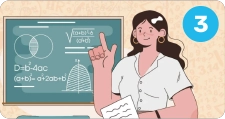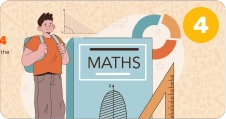Introduction
Lines are everywhere in mathematics, from basic geometry to advanced algebra. Among them, intersecting lines are very important because they help in solving angle problems, equations, and real-world scenarios like road crossings or railway tracks. Let’s learn how to identify intersecting lines and how to use them in different math problems with examples and diagrams.
What Are Intersecting Lines?

Intersecting lines are two or more lines that cross each other at exactly one point, known as the point of intersection. At this point, they form angles, which may be acute, obtuse, or right angles.
Example: The letter X is a simple representation of intersecting lines.
Properties of Intersecting Lines
- They meet at a single point.
- They form pairs of vertically opposite angles, which are always equal.
- The total sum of all angles at the intersection is 360°.
- Adjacent angles formed by intersecting lines are always supplementary (add up to 180°).
How to Identify Intersecting Lines
1. Definition Check
If two lines cross each other at one point, they are intersecting. If they never meet and stay the same distance apart, they are parallel.
2. Visual Check
Draw two lines on paper. If they meet at a single point, they are intersecting lines. If not, they might be parallel.
3. Algebraic Check
- Solving Equations: If the equations of two lines are given, solve them simultaneously.
- Unique Solution: If the system gives a unique solution (an exact coordinate), then the lines intersect at that point.
- No Solution: If there is no solution, the lines are parallel.
How to Use Intersecting Lines in Math Problems
-
Finding the Intersection Point
If two lines are given in the form of equations:\(\displaystyle m_{1}x + c_{1} = m_{2}x + c_{2}\)
Step 1: Set the two equations equal.
Step 2: Solve for \(\displaystyle x\).
Step 3: Substitute the x-value back into either equation to find \(\displaystyle y\).
The solution \(\displaystyle (x, y)\) gives the point of intersection.
-
Working with Vertical Angles
When two lines intersect, opposite (vertical) angles are always equal.
Example: If one angle is \(\displaystyle 70^{\circ}\), the angle directly opposite will also be \(\displaystyle 70^{\circ}\). -
Working with Adjacent Angles
Adjacent angles are side by side at the intersection point and always add up to \(\displaystyle 180^{\circ}\).
Example: If one angle is \(\displaystyle 110^{\circ}\), the adjacent angle will be \(\displaystyle 70^{\circ}\).
Example Problem
Given: Two lines with equations \(\displaystyle y = 2x + 1\) and \(\displaystyle y = -x + 4\).
Step 1 – Identify: Slopes are \(\displaystyle 2\) and \(\displaystyle -1\). Since they are different, the lines must intersect.
Step 2 – Find x:
\(\displaystyle 2x + 1 = -x + 4\)
\(\displaystyle 3x = 3\)
\(\displaystyle x = 1\)
Step 3 – Find y:
Substitute \(\displaystyle x = 1\) into \(\displaystyle y = 2x + 1\)
\(\displaystyle y = 2(1) + 1 = 3\)
Intersection Point: \(\displaystyle (1, 3)\)
Diagrams of Intersecting Lines
1. Basic Intersecting Lines
(already created, more can be added in sets like with angles labeled if you want)
Conclusion
Intersecting lines are an essential part of geometry and algebra. They help in solving problems related to angles, equations, and coordinate geometry. By learning how to identify and use intersecting lines, students can strengthen their problem-solving skills and apply these concepts to both classroom exercises and real-life situations.
Want to spark your child’s interest in math and boost their skills? Moonpreneur’s online math curriculum stands out because it engages kids with hands-on lessons, helps them apply math in real-life situations, and makes learning math exciting!
You can opt for our Advanced Math or Vedic Math+Mental Math courses. Our Math Quiz for grades 3rd, 4th, 5th, and 6th helps in further exciting and engaging in mathematics with hands-on lessons.
FAQs
Ans: Check if they meet at a point visually or solve their equations to see if there’s a unique solution.
Ans: No, they can form different types of angles (acute, obtuse, or right).
Ans: Parallel lines never meet, while intersecting lines always meet at one point.
Related Blog:
How to Teach Adjacent Angles to Kids | Simple & Fun Guide
What are Congruent Angles?
Understanding Alternate Interior Angles
What is the Area of Trapezoid?
What is the Area of Parallelogram?
Understanding the Geometry Regents: A Comprehensive Guide
How to Prepare for the Geometry Regents: Study Plans & Practice
The Art of Geometry: How to Draw an Equilateral Triangle Inside a Circle















